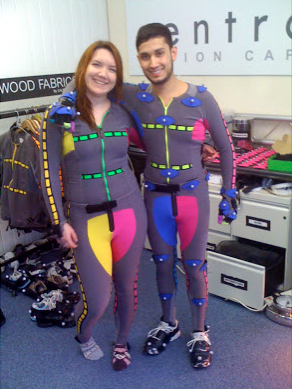Motion capture
Motion capture (often abbreviated as mocap) is the process of recording the movement of objects or people. It is used in entertainment, sports, medical applications, and for validation of computer vision and robotics. In filmmaking and video game development, it refers to recording actions of human actors and using that information to animate digital character models in 3D computer animation.
History
Motion capture has its roots in the early 20th century with the work of Eadweard Muybridge and Étienne-Jules Marey, who used sequential photography to study human and animal motion. The modern form of motion capture began in the 1970s with the development of optical systems that could track reflective markers placed on a subject.
Technology
Motion capture technology can be divided into several categories:
Optical Systems
Optical systems use cameras to track markers placed on the subject. These markers can be passive (reflective) or active (LEDs). The data from the cameras is then processed to create a 3D representation of the subject's movements.
Inertial Systems
Inertial systems use accelerometers and gyroscopes to track the movement of the subject. These systems do not require external cameras and can be used in a wider range of environments.
Magnetic Systems
Magnetic systems use sensors to detect the position and orientation of the subject within a magnetic field. These systems can be affected by metal objects and other magnetic fields in the environment.
Mechanical Systems
Mechanical systems use exoskeletons or other mechanical devices to track the movement of the subject. These systems can provide very accurate data but can be cumbersome to wear.
Applications
Motion capture is used in a variety of fields:
Entertainment
In the entertainment industry, motion capture is used to create realistic animations for films, television, and video games. Notable examples include the character Gollum in The Lord of the Rings film series and the video game L.A. Noire.
Sports
In sports, motion capture is used to analyze and improve athletic performance. It can be used to study the biomechanics of athletes and to develop training programs.
Medical Applications
In medicine, motion capture is used to study human movement and to develop treatments for conditions such as cerebral palsy and Parkinson's disease. It is also used in rehabilitation to track the progress of patients.
Robotics
In robotics, motion capture is used to develop and test algorithms for robot motion and to validate the performance of robotic systems.
Related Pages
See Also
References
External Links
Transform your life with W8MD's budget GLP-1 injections from $125.
W8MD offers a medical weight loss program to lose weight in Philadelphia. Our physician-supervised medical weight loss provides:
- Most insurances accepted or discounted self-pay rates. We will obtain insurance prior authorizations if needed.
- Generic GLP1 weight loss injections from $125 for the starting dose.
- Also offer prescription weight loss medications including Phentermine, Qsymia, Diethylpropion, Contrave etc.
NYC weight loss doctor appointments
Start your NYC weight loss journey today at our NYC medical weight loss and Philadelphia medical weight loss clinics.
- Call 718-946-5500 to lose weight in NYC or for medical weight loss in Philadelphia 215-676-2334.
- Tags:NYC medical weight loss, Philadelphia lose weight Zepbound NYC, Budget GLP1 weight loss injections, Wegovy Philadelphia, Wegovy NYC, Philadelphia medical weight loss, Brookly weight loss and Wegovy NYC
|
WikiMD's Wellness Encyclopedia |
| Let Food Be Thy Medicine Medicine Thy Food - Hippocrates |
Medical Disclaimer: WikiMD is not a substitute for professional medical advice. The information on WikiMD is provided as an information resource only, may be incorrect, outdated or misleading, and is not to be used or relied on for any diagnostic or treatment purposes. Please consult your health care provider before making any healthcare decisions or for guidance about a specific medical condition. WikiMD expressly disclaims responsibility, and shall have no liability, for any damages, loss, injury, or liability whatsoever suffered as a result of your reliance on the information contained in this site. By visiting this site you agree to the foregoing terms and conditions, which may from time to time be changed or supplemented by WikiMD. If you do not agree to the foregoing terms and conditions, you should not enter or use this site. See full disclaimer.
Credits:Most images are courtesy of Wikimedia commons, and templates, categories Wikipedia, licensed under CC BY SA or similar.
Contributors: Prab R. Tumpati, MD





